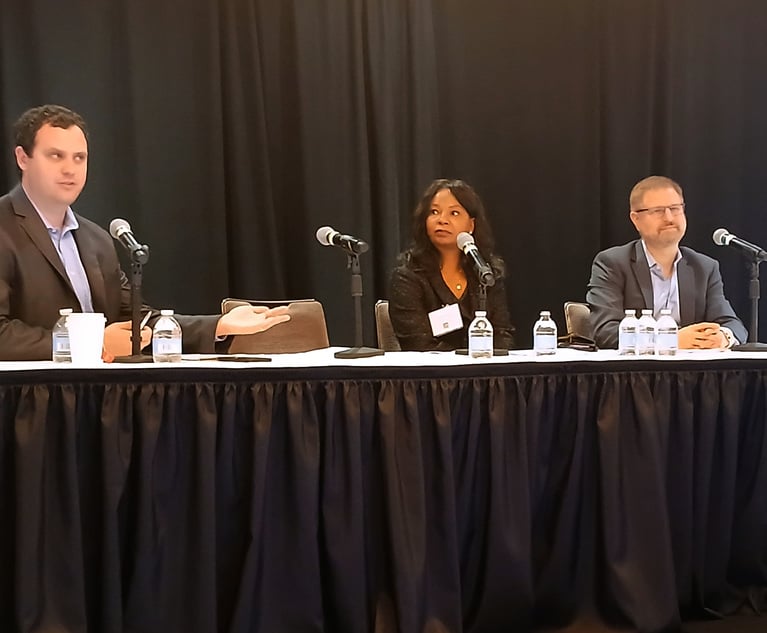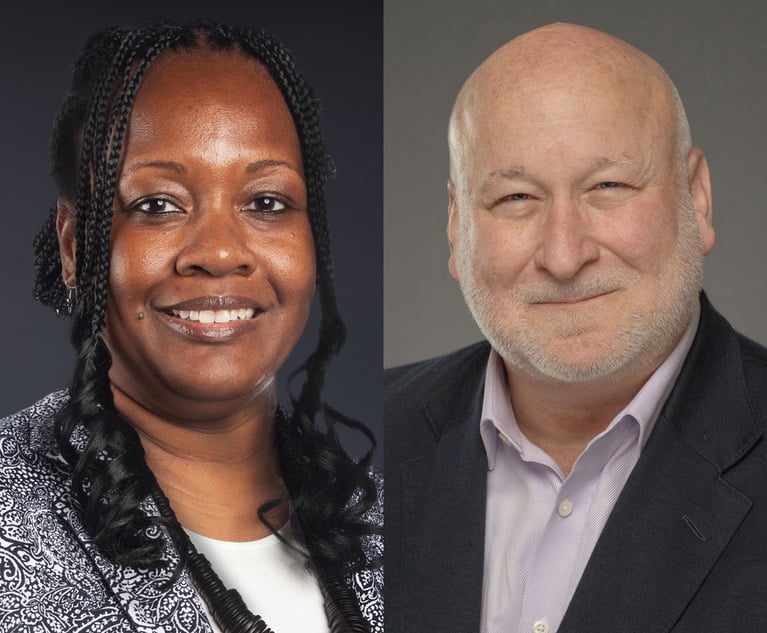Superfund Scuffle Sparks High Court Review
Ruling drastically expands hazardous materials liability.
December 31, 2008 at 07:00 PM
12 minute read
From 1960 to 1989, Brown & Bryant Inc. operated an agricultural chemical distribution facility on a 4.7-acre parcel of land in Arvin, Calif. Over the course of those three decades, chemicals from the facility contaminated a pond on the property and leaked into the surrounding groundwater.
When the California Department of Toxic Substances Control (CDTSC) discovered the mess, it undertook an extensive environmental remediation that cost $1.3 million. Then it started looking for culpable parties to help foot the bill. But Brown & Bryant was nowhere to be found. The company had gone out of business.
The Comprehensive Environmental Response, Compensation and Liability Act (CERCLA)–also known as the Superfund Act–authorizes the government to seek compensation from a wide array of so-called “potentially responsible parties,” including owners of the contaminated land, transporters of hazardous substances and parties that arranged for the disposal or treatment of the hazardous substances. That last category gave CDTSC and the EPA a foothold. They sued Shell Oil, seeking to hold it liable as an “arranger.”
Shell's only connection to the contamination in Arvin was that it had sold two chemicals to Brown & Bryant under a marketing agreement for the resale of the chemical. The government also sued Burlington Northern Santa Fe Railroad, which leased Brown & Bryant a small parcel of land when it expanded its operations in 1975.
When the 9th Circuit decided the case, it shocked many environmental lawyers. The court held Shell and Burlington Northern jointly and severally liable for the entire cost of the cleanup. The Supreme Court agreed to review the controversial decision in October, and oral arguments will be heard in January.
 |
| Cleaning up the Brown & Bryant spill cost $1.3 million. |
“The 9th Circuit decision is a huge expansion of both the common law and Superfund,” says Charles Moellenberg, a Jones Day partner who wrote an amicus brief supporting certiorari on behalf of the Product Liability Advisory Counsel. “It's a clear case of government overreaching in search of deep pockets.”
Shifting the Burden
While CERCLA doesn't specifically define “arranger,” most courts have held the term only encompasses those parties with some connection to the polluting activity, such as transporting the contaminating substance to a disposal site. The 9th Circuit's reading expands “arranger” to include parties that sell a hazardous product that later drips, leaks or spills in any way.
Shell's main issue with this reading is that it had no control over the activities that caused the pollution in Arvin. To the contrary, Shell introduced evidence that it shipped the chemical in appropriate containers and provided Brown & Bryant with information and instructions for safely handling, storing and disposing of the product. The pollution happened only because Brown & Bryant employees mishandled the deliveries.
Business advocates warn that the 9th Circuit's decision will have severe economic consequences that could cripple companies that manufacture and sell useful chemical products.
“Companies will either have to charge a very high amount to cover this liability or stop selling the product altogether,” says Fred Hiestand, general counsel of the Civil Justice Association of California, a business advocacy group that served as an amicus in Shell.
To avoid this result, Burlington Northern asked the court to at least apportion the liability based on each party's relative fault for the contamination. The district court agreed to do so. It assessed 9 percent of the cost to Burlington, taking into account several factors–the parcel the railroad leased to Brown & Bryant constituted 19 percent of the total lot, the railroad parcel was used for 13 of the 29 years the facility was in operation, and 66 percent of the hazardous products were attributable to the railroad parcel. The court fixed Shell's liability at 6 percent, representing the proportion of spills involving Shell's fertilizer (D-D) that occurred during deliveries.
When the 9th Circuit heard Shell's appeal, however, it upheld the part of the decision that held Shell liable, but reversed the part that apportioned the liability–finding the contamination was not divisible and slamming the two defendants with the whole bill.
Circuit Split
Every other circuit court that has considered the question of arranger liability has imposed an intent or knowledge requirement before holding a mere seller of a finished product liable for clean-up costs (see “Conflicting Viewpoints”). For example, in Amcast v. Detrex, the 7th Circuit ruled that “the spiller, but not the shipper of the chemical that spilled, is within the Act's long reach. … The words 'arranged for' … imply intentional action.”
Circuit Judge Carlos Bea was troubled by the conflict the Shell decision creates. “The panel's interpretation of CERCLA 'arranger' liability creates intra- and inter-circuit conflicts in an area of the law where uniformity among circuits is of paramount importance,” he wrote in his dissent.
“The 9th Circuit had to engage in legal alchemy to put Shell on the hook,” Moellenberg says. “It's an outlier decision.”
Businesses are hoping that the Supreme Court will bring the 9th Circuit back in line.
From 1960 to 1989, Brown & Bryant Inc. operated an agricultural chemical distribution facility on a 4.7-acre parcel of land in Arvin, Calif. Over the course of those three decades, chemicals from the facility contaminated a pond on the property and leaked into the surrounding groundwater.
When the California Department of Toxic Substances Control (CDTSC) discovered the mess, it undertook an extensive environmental remediation that cost $1.3 million. Then it started looking for culpable parties to help foot the bill. But Brown & Bryant was nowhere to be found. The company had gone out of business.
The Comprehensive Environmental Response, Compensation and Liability Act (CERCLA)–also known as the Superfund Act–authorizes the government to seek compensation from a wide array of so-called “potentially responsible parties,” including owners of the contaminated land, transporters of hazardous substances and parties that arranged for the disposal or treatment of the hazardous substances. That last category gave CDTSC and the EPA a foothold. They sued Shell Oil, seeking to hold it liable as an “arranger.”
Shell's only connection to the contamination in Arvin was that it had sold two chemicals to Brown & Bryant under a marketing agreement for the resale of the chemical. The government also sued Burlington Northern Santa Fe Railroad, which leased Brown & Bryant a small parcel of land when it expanded its operations in 1975.
When the 9th Circuit decided the case, it shocked many environmental lawyers. The court held Shell and Burlington Northern jointly and severally liable for the entire cost of the cleanup. The Supreme Court agreed to review the controversial decision in October, and oral arguments will be heard in January.
This content has been archived. It is available through our partners, LexisNexis® and Bloomberg Law.
To view this content, please continue to their sites.
Not a Lexis Subscriber?
Subscribe Now
Not a Bloomberg Law Subscriber?
Subscribe Now
NOT FOR REPRINT
© 2024 ALM Global, LLC, All Rights Reserved. Request academic re-use from www.copyright.com. All other uses, submit a request to [email protected]. For more information visit Asset & Logo Licensing.
You Might Like
View All
Lawyers Drowning in Cases Are Embracing AI Fastest—and Say It's Yielding Better Outcomes for Clients

GC Conference Takeaways: Picking AI Vendors 'a Bit of a Crap Shoot,' Beware of Internal Investigation 'Scope Creep'
8 minute read
Why ACLU's New Legal Director Says It's a 'Good Time to Take the Reins'
Trending Stories
- 1Decision of the Day: Judge Reduces $287M Jury Verdict Against Harley-Davidson in Wrongful Death Suit
- 2Kirkland to Covington: 2024's International Chart Toppers and Award Winners
- 3Decision of the Day: Judge Denies Summary Judgment Motions in Suit by Runner Injured in Brooklyn Bridge Park
- 4KISS, Profit Motive and Foreign Currency Contracts
- 512 Days of … Web Analytics
Who Got The Work
Michael G. Bongiorno, Andrew Scott Dulberg and Elizabeth E. Driscoll from Wilmer Cutler Pickering Hale and Dorr have stepped in to represent Symbotic Inc., an A.I.-enabled technology platform that focuses on increasing supply chain efficiency, and other defendants in a pending shareholder derivative lawsuit. The case, filed Oct. 2 in Massachusetts District Court by the Brown Law Firm on behalf of Stephen Austen, accuses certain officers and directors of misleading investors in regard to Symbotic's potential for margin growth by failing to disclose that the company was not equipped to timely deploy its systems or manage expenses through project delays. The case, assigned to U.S. District Judge Nathaniel M. Gorton, is 1:24-cv-12522, Austen v. Cohen et al.
Who Got The Work
Edmund Polubinski and Marie Killmond of Davis Polk & Wardwell have entered appearances for data platform software development company MongoDB and other defendants in a pending shareholder derivative lawsuit. The action, filed Oct. 7 in New York Southern District Court by the Brown Law Firm, accuses the company's directors and/or officers of falsely expressing confidence in the company’s restructuring of its sales incentive plan and downplaying the severity of decreases in its upfront commitments. The case is 1:24-cv-07594, Roy v. Ittycheria et al.
Who Got The Work
Amy O. Bruchs and Kurt F. Ellison of Michael Best & Friedrich have entered appearances for Epic Systems Corp. in a pending employment discrimination lawsuit. The suit was filed Sept. 7 in Wisconsin Western District Court by Levine Eisberner LLC and Siri & Glimstad on behalf of a project manager who claims that he was wrongfully terminated after applying for a religious exemption to the defendant's COVID-19 vaccine mandate. The case, assigned to U.S. Magistrate Judge Anita Marie Boor, is 3:24-cv-00630, Secker, Nathan v. Epic Systems Corporation.
Who Got The Work
David X. Sullivan, Thomas J. Finn and Gregory A. Hall from McCarter & English have entered appearances for Sunrun Installation Services in a pending civil rights lawsuit. The complaint was filed Sept. 4 in Connecticut District Court by attorney Robert M. Berke on behalf of former employee George Edward Steins, who was arrested and charged with employing an unregistered home improvement salesperson. The complaint alleges that had Sunrun informed the Connecticut Department of Consumer Protection that the plaintiff's employment had ended in 2017 and that he no longer held Sunrun's home improvement contractor license, he would not have been hit with charges, which were dismissed in May 2024. The case, assigned to U.S. District Judge Jeffrey A. Meyer, is 3:24-cv-01423, Steins v. Sunrun, Inc. et al.
Who Got The Work
Greenberg Traurig shareholder Joshua L. Raskin has entered an appearance for boohoo.com UK Ltd. in a pending patent infringement lawsuit. The suit, filed Sept. 3 in Texas Eastern District Court by Rozier Hardt McDonough on behalf of Alto Dynamics, asserts five patents related to an online shopping platform. The case, assigned to U.S. District Judge Rodney Gilstrap, is 2:24-cv-00719, Alto Dynamics, LLC v. boohoo.com UK Limited.
Featured Firms
Law Offices of Gary Martin Hays & Associates, P.C.
(470) 294-1674
Law Offices of Mark E. Salomone
(857) 444-6468
Smith & Hassler
(713) 739-1250







